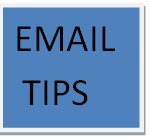Writing an email help request that gets results
“I NEED HELP!” This line will get your email recipient’s attention. But email help requests that sound this desperate won’t get the results you seek. Nor will requests that are too subtle. Strike a balance to achieve the best results.
Let me illustrate what works—and what doesn’t—with a before-and-after example of a financial professional’s email request for help. Imagine that you’re a financial blogger asking respected experts to contribute to an article, and you need their responses by a specific date. How would you tackle it? The writer of “Email help request 1” makes mistakes.
Email help request 1
Here’s “Email help request 1”
Re: article on my blog
Hi Charlie,
I am writing the latest article for my blog, which I update weekly. I think it would be great if you could contribute something to my blog. My readers are interested in saving for retirement and you write a lot of articles about retirement. Your good name could help me get better known in this space. Could you send me your opinions on what works in terms of rolling over a traditional IRA into a Roth IRA? It would be great if you could reply by the second week in March.
Compared with “Email help request 1,” the author of the next email writes in a way that’s easier for the recipient to understand.
Email help request 2
Re: Answer Roth IRA question by March 6?
Hi Charlie,
Our mutual friend, Janet Brown suggested, I contact you because she thinks you would be a great expert to contribute to my blog. Also, she experienced a boost in her e-newsletter subscribers after contributing to my blog last month.
By Tuesday, March 7, could you briefly answer my question about Roth IRAs, so I can incorporate your answer into a blog post? Here’s my question: How does an individual’s number of years until expected retirement affect the attractiveness of rolling a traditional IRA into a Roth IRA? After I compile my blog post, I will check to make sure that I’ve presented your views accurately.
My blog receives 5,000 views monthly, and my target audience of dog-owners in their 50s and 60s for my financial planning business seems to overlap with your target as a consultant. I’d be happy to link to your website and feature your photo in my blog.
Please let me know if you have any questions. I’ll call you next week if I don’t hear from you.
What makes an email help request effective?
I believe the second email request will be more effective than the first.
Why will the second email work better?
- The subject line clearly identifies the reason for the email.
- The first paragraph establishes a relationship between the writer and the recipient, by referring to their mutual friend.
- The second paragraph says exactly what the writer is seeking, including the deadline for a reply.
- The third paragraph (and the end of the first paragraph) suggests how the recipient may benefit from responding to the writer’s request. This contrasts with the first email that is mostly about the sender
- Breaking the email into paragraphs makes it easier for the recipient to absorb the information.
- The promise—threat?—of a follow-up may spur the recipient to reply, even if it’s just to say “No, thanks.”
The first email is too self-centered and makes the reader work too hard to figure out what the writer wants.
If you enjoyed this post, you may also enjoy “Top four email mistakes to avoid when you have a referral.”
Image courtesy of Keerati at FreeDigitalPhotos.net.





